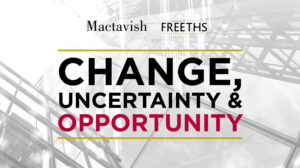
Learning the lessons of the past, building on our knowledge and understanding of risk quantification and probability are the basic fundamentals that drive our industry forward. As I write, underwriters are using incredibly advanced modelling to determine the likelihood, severity and aggregation of risk so as to ensure they have sufficient capital available to meet their clients’ needs – on terms that they hope prove sustainable and profitable. I would argue that the insurance sector’s ability to rise to this challenge has been one of the great success stories that makes modern capitalism possible.
Yet, while we may have significant confidence in our ability to comprehend and assess an aggregated set of risks, we still suffer from blind-spots that can lead our modelling astray. One of these is the area of emerging risks, where, with little historical data to go on, it is extremely difficult to predict the future. As the economy we serve evolves at an unprecedented pace, all insurers are faced with the challenge of meeting the demand for products such as cyber insurance, knowing that as they do so, the potential for miscalculation is huge.
The struggle to quantify emerging risk is unavoidable and a consequence of unparalleled change. But the issue I want to focus on, is of a different category altogether. When it comes to issuing cover for individual businesses, insurers can still be blindsided by factors that are not intrinsically unknowable. This isn’t a failure of modelling or understanding, instead it stems from the age-old weaknesses of knowledge transfer between individuals and institutions, i.e. communication.
Clarity and communication:
When I reflect on my career and consider the various issues and disputes that I have witnessed between insurers and their clients, most have not been the result of bad-faith or miscalculation, but rather have revolved around issues of disclosure and communication. An insurer believes that a client has not made clear some vital aspect of their risk, or the policyholder complains that their policy has not offered cover in the way that they understood it would do at the point of sale. These are ‘surprises’ based on miscommunication. One of the parties was seen to be in possession of information that led to the detriment of the other.
This brings us to the question of how information flows between insured and insurer in the normal course of business. The very largest firms deploy extensive resources to assess and understand their own risks. They are well-placed to communicate directly with underwriters – and there is a growing trend for them to do just that.
Most businesses follow the traditional policyholder-broker-insurer model. It has generally been “the way we do business around here”. To anyone who’s ever played ”Chinese Whispers”, this creates an extended chain that offers the potential for miscommunication or misunderstanding. Another set of people must grasp and transfer the relevant data from one party to another. An additional set of incentives and interests enters the mix. This increases the chance for error, even if everyone involved is acting as diligently as possible and aspiring to the highest of professional standards.
In a hard market, the potential for error becomes greater still. As broking resources are stretched, clients are under additional stress and underwriters are navigating new internal constraints, the amount of time available for discovery and discussion becomes limited. Inevitably, this means that there is a heightened risk that one or more of the parties involved in a transaction will make a mis-judgement.
Creating a ‘no surprises’ culture:
There have been many great strides made by the industry in recent decades to help overcome this problem of sharing complex information. The Insurance Act 2015 (which Mactavish was heavily involved with) also helped by clarifying the rules around disclosure and introducing the Duty of Fair Presentation.
However, there have also been countervailing trends that have made things worse. The extensive use of standardised, off-the-peg policies sold through facilities can create a mismatch between policyholder needs and expectations, and limit analysis of the realities of the coverage provided in the actual wordings.
At Mactavish, we see a core part of our purpose as being to enhance the understanding between all parties and to create what we call a ‘no surprises culture’. Losses will, of course, always occur – if they did not, we wouldn’t have a product or jobs. But we do believe that disputes and surprises caused by miscommunication can be radically reduced, to the benefit of all parties.
We achieve this in four key ways:
- Firstly, we take the time to truly understand our clients’ risks. This is a lengthy process that involves risk analysis, interviews with key stakeholders and detailed scenario analysis. We stick close to our clients, really getting under the skin of their business.
- Secondly, we promote vastly improved disclosure that goes well beyond market norms. Our prospectuses and submissions are detailed, technically accurate and honest. They offer great insights that help underpin sound dialogue between policyholder and potential underwriter
- Thirdly, we do not act as a gatekeeper to our clients, instead we see our role as being to facilitate and enhance communication between the companies we represent, their brokers and the insurers who take on their risk.
- Finally, we really get to grips with the details of the coverage being offered, ensuring that our clients understand precisely what they are buying. When the wording does not meet client requirements we negotiate with decision makers to reach an accommodation. Of course, each party does not always get exactly what they want, but the crucial difference is that they both understand exactly what compromises they are agreeing to.
The result of this approach is that policyholders pay a fair price, for cover they understand, and underwriters are less likely to be blindsided as a result of miscommunication or knowable ‘unknowns’. This allows insurers to tailor their products and to build sustainable valued relationships with their customers, it creates trust and most importantly, it brings added confidence regarding the fundamentals of risk quantification and probability I mentioned at the beginning of this article.
If you would like to discuss how Mactavish can support you in this challenging risk arena I’d be delighted to set up a call to explain how we are applying our unique approach to clients’ businesses across the UK and beyond.
Head of Corporate Customer Solutions
Tomwhite@mactavishgroup.com




